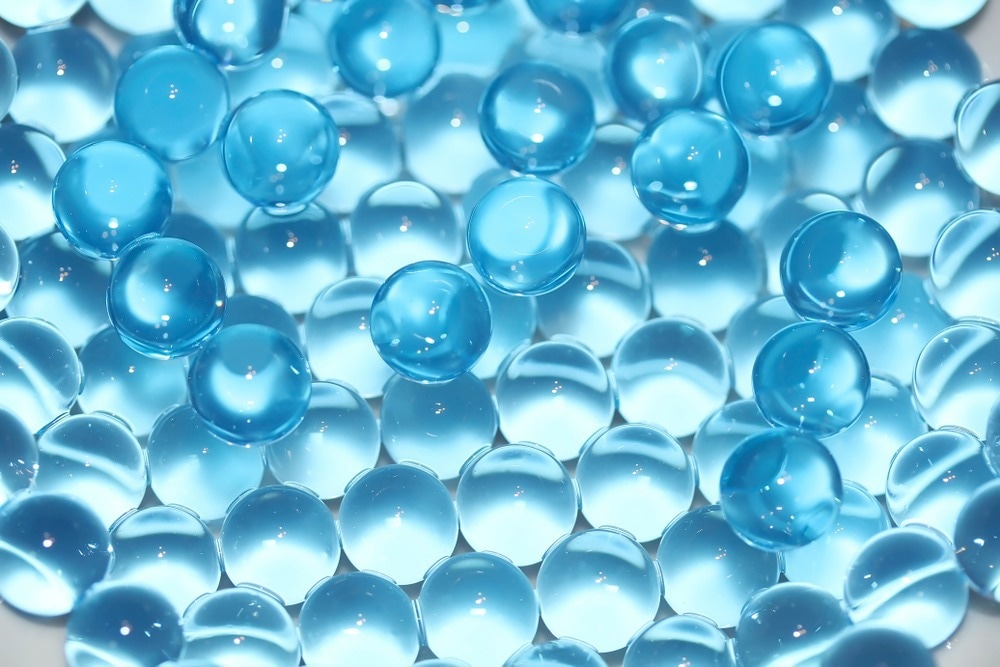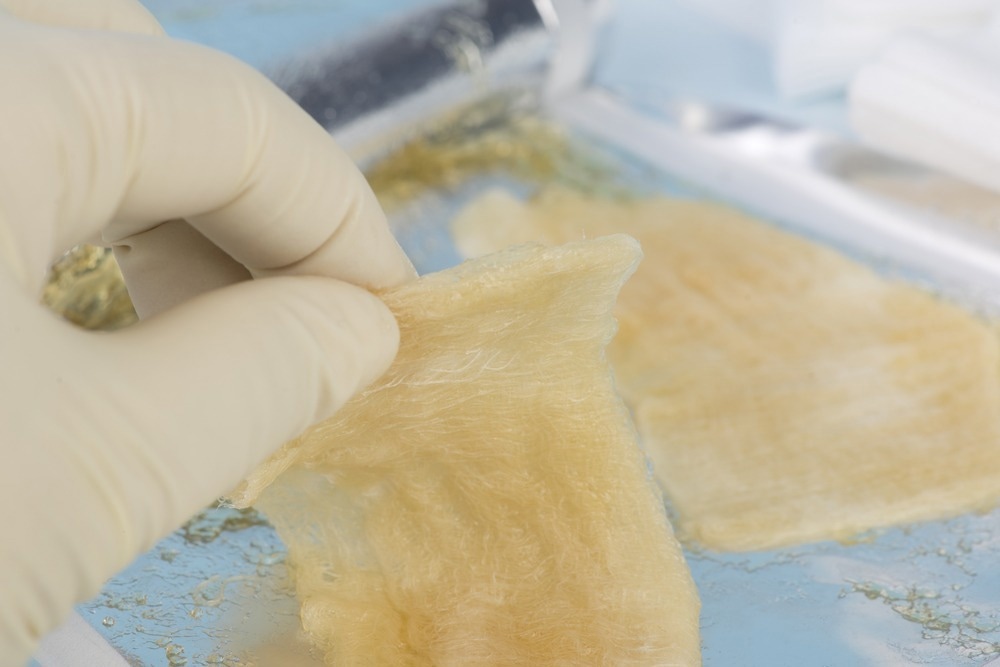Reinforcing hydrogels with boron nitride nanosheets enhances mechanical, thermal, and self-healing properties, making them versatile platforms for advanced electronics, biomedicine, soft robotics, and environmental devices. This article highlights the diverse applications and future outlook for boron nitride-based hydrogels.

Image Credit: Kateryna Kozlova/Shutterstock.com
Unveiling the Potential of Boron Nitride Hydrogels
Hydrogels are 3D networks of hydrophilic polymers that can absorb and retain large amounts of water due to physical or chemical cross-linking of individual polymer chains. However, poor mechanical strength and thermal conductivity often limit their practical use. An emerging solution is reinforcing hydrogels with nanoparticles to form nanocomposite hydrogels.
In particular, incorporating boron nitride (BN) creates a unique class of mechanically robust and thermally conductive hydrogels with self-healing capabilities. Hexagonal boron nitride nanosheets (BNNS), often regarded as structural and isoelectronic analogs of graphene, boast exceptional thermal and chemical stability and impressive mechanical strength.
This integration enhances thermal conductivity, Young's modulus, mechanical strength, and self-healing capacity, addressing the limitations of conventional hydrogels.
BN-based nanocomposite hydrogels are synthesized by blending aqueous BN nanoparticle dispersions with monomers or polymeric chains, typically dissolved in water or, in some instances, ethanol.
These nanocomposite hydrogels find applications in various domains, including drug delivery, water treatment, tissue engineering, thermal interface materials, soft robotics, and microlenses.
Biomedical and Drug Delivery Applications
Boron nitride nanocomposite hydrogels have great potential for biomedical applications because of the biocompatibility of hydrogels and BN.
Hydrogels mimic the cellular environment, while BN is biodegradable, and its boron degradation products can promote wound healing and treat prostate cancers. In addition, BN-based nanocomposite hydrogels stimulate the growth of hard tissues by promoting hydroxyapatite deposition, a crucial component of bones and teeth.
Boron nitride hydrogels have great potential in drug delivery and smart applications, offering precise control over therapeutic agent release by tailoring their properties. Their high specific surface area, hydrophobic surface, and pi systems enable effective drug interactions through electrostatic and pi-pi interactions.
In addition, the choice of BN nanostructure and its functionalization significantly affects its compatibility with therapeutic agents and plays a crucial role in determining drug uptake and release behavior.
Heat Management in Electronics
Boron nitride hydrogels are increasingly valuable in electronic applications, especially for effective heat management. They find essential use as thermal interface materials (TIMs) to protect microelectronics from heat-induced damage by facilitating heat transfer.
These hydrogels are also vital in developing antipyretic pastes, as they can replicate rough surface textures, enabling effective air expulsion from gaps and facilitating efficient thermal transfer between electronic devices and heat sinks. Traditional solid TIMs often struggle to fill these gaps and are not easily recyclable or adaptable to different rough surfaces.
However, the applicability of BN hydrogels may be limited by the operating temperature range of electronics (e.g., 40-60°C for CPUs) since high temperatures can dehydrate hydrogels and alter thermal conductivity.
Various strategies, such as using hybrid hydrogel-elastomer materials and incorporating glycerol, have been explored to overcome this limitation. Glycerol prevents water evaporation and provides anti-freezing properties, expanding the hydrogels' applicability in electronic settings to a higher temperature range.

Image Credit: MedstockPhotos/Shutterstock.com
Soft Actuators and Wearable Devices
Self-healing relies on the material's capacity to mend damage, restoring lost properties or performance by leveraging inherent resources. This involves closing cracks through mass transfer and reconnecting broken chemical bonds between separated parts through non-covalent or covalent links.
Incorporating boron nitride nanosheet (BNNS) in hydrogels enhances mechanical and functional properties and significantly contributes to the self-healing mechanisms.
This self-healing property is particularly valuable in tissue engineering, emulating natural tissue's ability to repair spontaneously. It also finds application in scenarios involving cyclic mechanical loadings, such as soft actuators and wearable devices, where self-healing capability is advantageous.
Environmental Applications: Swelling and Water treatment
Boron Nitride Hydrogels have versatile applications in environmental contexts, particularly in water treatment. Their ability to interact effectively with organic pollutants like dyes and oils and inorganic pollutants such as heavy metal ions makes them attractive for pollutant removal from water.
A study published in materials demonstrated that amino functionalized boron nitride nanosheets/poly(N-isopropyl acrylamide) (NH2-BNNS/PNIPAM) hydrogel has high absorption capacity for hydrophilic dyes and diesel, as it completely removed these pollutants after hot water immersion. This highlights their value in environmental applications, specifically swelling and water treatment.
Microwave Electromagnetic Absorption
Wang et al. offered an alternative application for BN composites, emphasizing their potential to enhance microwave electromagnetic absorption. The researchers suggest employing hydrogel/boron nitride composites to create 3D, self-supporting structures that improve electromagnetic microwaves' incidence and reflective paths.
This application aims to address electromagnetic pollution generated by various electronic devices, with the noble goal of mitigating health issues.
Embracing a Promising Future with Boron Nitride Hydrogels
Boron Nitride Hydrogels offer unique properties, from enhancing thermal conductivity and mechanical strength through covalent bonding with BN nanosheets (BNNS) to advancing self-healing capabilities via pi-pi interactions.
These hydrogels find applications in soft robotics, therapeutic agent delivery, and pollutant removal, where interactions with solutes are crucial. The hydrophobic nature of BN nanostructures and potential electrostatic and pi-pi interactions open doors to improved compatibility with hydrophobic drugs and pollutants, especially when functionalized.
The future of BN-nanocomposite hydrogels lies in continued innovation in BN nanostructure functionalization, fabrication, and synergistic combination with other nanofillers. Additionally, progress in double network hydrogels, supramolecular hydrogels, stimuli-responsive hydrogels, and cross-linking chemistry will further expand these remarkable materials' range of properties and applications.
In essence, Boron Nitride Hydrogels hold immense potential to revolutionize many industries, urging us to embark on a journey of exploration and innovation to harness their full capabilities.
References and Further Reading
Lima, D. M., et al. (2021). Boron nitride-based nanocomposite hydrogels: Preparation, properties and applications. Soft Matter, 17(17), pp. 4475-4488. doi.org/10.1039/D1SM00212K
Hu, X., et al. (2016). Aqueous compatible boron nitride nanosheets for high-performance hydrogels. Nanoscale, 8(7), pp. 4260-4266. doi.org/10.1039/C5NR07578E
Hongbo, J., et al. (2017) Highly flexible and self-healable thermal interface material based on boron nitride nanosheets and a dual cross-linked hydrogel. ACS Applied Materials & Interfaces 9(11), pp. 10078-10084. doi.org/10.1021/acsami.6b16195
Xue, S., et al. (2018). Boron nitride nanosheets/PNIPAM hydrogels with improved thermo-responsive performance. Materials, 11(7), p. 1069. doi.org/10.3390/ma11071069
Wang, F., et al. (2021). Boron nitride nanocomposites for microwave absorption: a review. Materials Today Nano, 13, p. 100108. doi.org/10.1016/j.mtnano.2020.100108
Bahram, M., et al. (2016). An Introduction to Hydrogels and Some Recent Applications. InTech. doi.org/10.5772/64301
Disclaimer: The views expressed here are those of the author expressed in their private capacity and do not necessarily represent the views of AZoM.com Limited T/A AZoNetwork the owner and operator of this website. This disclaimer forms part of the Terms and conditions of use of this website.